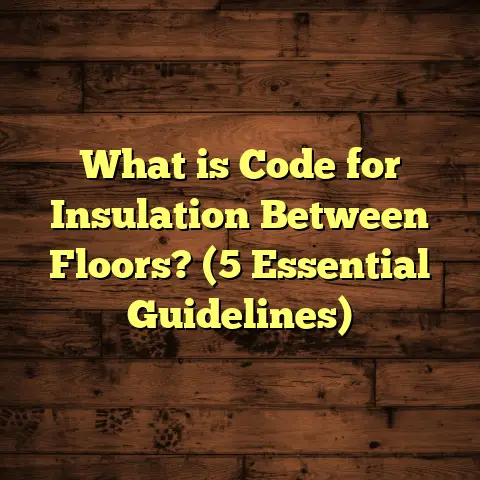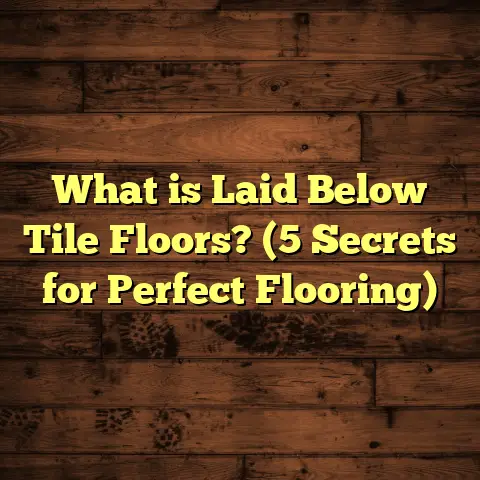What is Vinyl Flooring Tiles? (5 Key Benefits You Must Know)
Thinking About Upgrades?
When’s the last time you really looked at your floors? I mean, not just walked across them or swept the crumbs into a dustpan, but actually thought about how they shape the vibe of your home. I ask because over the years, I’ve noticed most people get so used to their old floors that they don’t realize how dramatically a change could improve their space—not just in terms of looks, but also with comfort, function, and even property value.
I can’t count how many times I’ve seen a customer’s jaw drop during a reveal. That “Wow, is this my house?” moment is why I love what I do. The right flooring isn’t just another upgrade—it’s a total game changer. And if you’re weighing your options—hardwood, tile, laminate, carpet—I want to share something that’s honestly blown me away in recent years: vinyl flooring tiles.
Let’s face it: home upgrades are never just about appearances. The best ones make your life easier every single day. You want something stylish, sure—but you also want floors that handle kids racing around, muddy paws, kitchen spills, and those “oops” moments when someone drops a glass or drags a chair. That’s where vinyl flooring tiles come in.
If you’ve only thought of vinyl as cheap or outdated, hang on. The technology and styles today are on a whole different level. I’ve been recommending them more and more, and the feedback from homeowners has been fantastic. So let’s talk about what makes vinyl flooring tiles so special—and why I believe everyone should at least consider them when planning their next upgrade.
What Are Vinyl Flooring Tiles?
Alright, let’s get straight to it: what are vinyl flooring tiles? If you’re picturing flimsy old peel-and-stick squares from the ‘80s—that’s not what I’m talking about here. Modern vinyl tiles are engineered products made from layers of synthetic materials, most notably polyvinyl chloride (PVC). They’re produced in individual pieces—usually squares or rectangles—that can be installed in endless configurations for tons of design flexibility.
Think of them as the chameleons of the flooring world. They can take on almost any look: wood planks, stone slabs, ceramic tile—even intricate patterns or custom graphics. But underneath those realistic surfaces is a tough, resilient structure built for performance.
Anatomy of a Vinyl Flooring Tile
Let’s break down what makes up a high-quality vinyl tile—as someone who installs these regularly, I know how much the details matter:
- Wear Layer
This is the tile’s clear top coat. It’s typically made from urethane or sometimes ceramic bead-infused coatings for extra durability. The wear layer shields the decorative print underneath from scratches, scuffs, stains, and UV fading. - Print Layer
Here’s where things get creative! High-resolution digital imaging technology prints realistic visuals—wood grains, stone veins, geometric motifs—onto a thin film that sits just below the wear layer. - Vinyl Core (Middle Layer)
This is the thickest part of the tile and is made of PVC resin mixed with plasticizers and stabilizers. It provides stability and resilience. Depending on the product, you might find reinforced fiberglass mesh to add extra strength. - Backing Layer
The bottom layer varies depending on the installation method. For peel-and-stick tiles, it’s an adhesive surface protected by a wax paper liner. For click-lock or loose-lay tiles, it might be cork or foam for sound absorption and added comfort.
Technical Specs That Matter
- Wear Layer Thickness: Residential tiles start at 6 mil (0.15mm) but 12–20 mil (0.3–0.5mm) is common for higher-end residential and commercial use.
- Total Thickness: Most luxury vinyl tiles (LVT) range from 2mm–6mm thick.
- Tile Size: Squares typically come in 12”x12”, 16”x16”, or 18”x18”. Planks (for wood looks) are often 6”x36” or 7”x48”.
- Fire Ratings: Most LVTs are ASTM E648 Class 1 rated for fire resistance—important for multifamily housing or commercial spaces.
- Slip Resistance: Coefficients of friction usually exceed 0.5 (per ASTM D2047), making them suitable for kitchens and bathrooms.
Manufacturing Process: How Are They Made?
I’ve visited several vinyl flooring plants over the years (I’m a bit of a nerd about this stuff), so let me walk you through the process:
- Mixing: Raw PVC resin is blended with plasticizers, stabilizers, pigments, and sometimes recycled content.
- Sheeting: The mixture is heated and extruded into long sheets.
- Laminating: The print film and wear layer are laminated onto the vinyl core under high heat and pressure.
- Texturing: Some products go through embossing rollers that press wood grain or stone textures into the surface—known as “embossed-in-register.”
- Cutting: The large sheets are cut into tiles or planks to exact sizes.
- Finishing: Edges may be beveled or squared off; quality checks ensure consistent thickness and color.
This entire process is highly automated and remarkably precise, which explains why today’s vinyl tiles aren’t anything like those bargain-bin options from decades past.
Types of Vinyl Tiles
You might see different names thrown around, but they break down into three main categories:
- Peel-and-Stick (Self-Adhesive): Easiest for DIYers—just peel off the backing and stick directly to a clean subfloor.
- Loose Lay: Heavier and backed with special friction layers that grip the subfloor without glue or nails.
- Click-Lock: These have interlocking edges like laminate flooring and float over an underlayment—no glue needed.
Each type has its pros and cons (I’ll share some stories about that later), but they all make for faster installs than traditional tile or hardwood.
So why do I keep recommending vinyl tiles to my clients? Let me walk you through five massive benefits—and why they matter in real-world homes like yours.
1. Durability That Surprises Everyone
I’ll be honest: when I first started working with modern LVT around 2010, even I was skeptical about how well it would stand up to heavy use. After seeing it hold up in schools, restaurants, busy homes—and even my own workshop—I’m a believer. Vinyl tiles are seriously tough.
Real-Life Performance
I once installed luxury vinyl tile for a family with four kids under ten (plus two Labradors). Their kitchen doubled as a playroom and art studio most days—and those kids were not gentle. After three years, the floor still looked great despite dropped toys, food spills, pet claws, and constant foot traffic.
I’ve got several rental property owners who switched from carpet to LVT for the same reason: it takes abuse in stride.
Why Are They So Tough?
- Wear Layer Protection: The clear top coat resists scratches from furniture legs, dog nails, dropped keys—or anything else daily life throws at it.
- Waterproof Construction: Unlike wood or laminate (which can swell), LVT won’t absorb water or warp—even if your dishwasher floods.
- Stain Resistance: Most vinyl tiles shrug off red wine, coffee, mud—even nail polish cleans up with acetone.
Technical Data & Studies
- Scratch Resistance: ASTM D3389 tests show premium LVT wear layers resist abrasion up to 10x longer than standard vinyl sheet goods.
- Indentation Recovery: ASTM F1914 measures resilience after heavy objects; LVT typically rebounds nearly 100% after furniture dents.
- Impact Testing: Dropping a steel ball from 36” caused permanent marks on hardwood but not on commercial-grade LVT (per Mannington R&D lab).
And here’s an eye-opener: According to Floor Covering News’ annual survey (2023), over 70% of property managers said LVT outlasted carpet and laminate by at least five years in high-traffic rentals.
2. DIY-Friendly Installation That Saves Time & Money
Let’s talk about something every homeowner cares about: hassle factor! Installing tile or hardwood is no small feat—trust me, I’ve done both for years (and spent plenty of weekends nursing sore knees). Vinyl tiles change the game here.
My First DIY Vinyl Tile Project
The first time I installed peel-and-stick tiles was in my own garage entryway years ago. With basic tools—a utility knife, straightedge, and tape measure—I finished a 60 sq ft landing in under two hours. No glue fumes or drying time, no special saws, no grout mess… just peel, stick, press.
Since then, I’ve coached dozens of friends and customers through their first DIY installs—bathrooms, laundry rooms, basements—and most finish in less than a day.
Install Methods Compared
- Peel-and-Stick: Perfect for smaller spaces or quick upgrades; just prep your subfloor well.
- Loose Lay: Easiest to remove if you’re renting or want to change styles later.
- Click-Lock: Best for large rooms; planks snap together tightly with no adhesives needed.
Cost & Labor Stats
- Professional install pricing: HomeGuide reports $1-$3/sq ft for LVT vs $8-$15/sq ft for hardwood or ceramic tile.
- DIY savings: According to Remodeling magazine’s Cost vs Value Report (2023), homeowners saved an average of $2,500 by installing LVT themselves compared to hiring out hardwood installation.
- Project timelines: A pro can finish an entire two-bedroom apartment in two days; most DIYers can do an average-size room in one weekend.
Tips From The Field
Always acclimate your tiles for at least 24 hours in the room before installing—especially if your climate gets humid or dry. And don’t underestimate subfloor prep: sweeping away dust and filling low spots makes a huge difference in finished results.
3. Affordability Without Looking Cheap
Let’s get real: budget matters for almost everyone—and with building materials going up year after year (the U.S. Bureau of Labor Statistics reports an 11% cost increase between 2021–2023 alone), finding ways to stretch your dollars really counts.
Vinyl flooring tiles give you that sweet spot: lower upfront costs without sacrificing style or durability.
Price Breakdown
Here’s what you might expect to pay per square foot (material only):
| Flooring Type | Entry Level | Mid Range | High End |
|---|---|---|---|
| Vinyl Tile | $1 | $3 | $6 |
| Laminate | $2 | $4 | $7 |
| Hardwood | $5 | $10 | $14+ |
| Ceramic/Porcelain | $4 | $7 | $15+ |
| Stone | $7 | $15 | $25+ |
And remember—vinyl tile installation is much cheaper too! No need for specialized labor (like certified tile setters), expensive adhesives/grouts, or subfloor reinforcement.
Real Case Study: Kitchen Remodel
A client recently wanted to freshen up their galley kitchen. Quotes for real oak hardwood came back at $4,200 (materials plus labor), while premium oak-look LVT was $1,150 installed—including removal of the old linoleum! She loved the look so much she added LVT to her laundry room for another $250.
Resale Value Considerations
A lot of buyers now recognize quality LVT as an upgrade compared to carpet or cheap laminates—especially in areas prone to water like kitchens and baths. According to Zillow’s Consumer Housing Trends Report (2022), homes listing “new luxury vinyl plank/tile flooring” sold 8% faster on average than those with older carpet or laminate.
4. Design Freedom and Realism
If you love options—or have ever dreamed of having marble floors without worrying about stains—this benefit will be your favorite!
Incredible Range of Looks
Thanks to digital printing and improved embossing technology, vinyl tiles now come in thousands of styles:
- Reclaimed barnwood planks
- Whitewashed oak
- Weathered slate
- Marble hexagons
- Geometric encaustic patterns
- Even metallic finishes for ultra-modern spaces
Some manufacturers (like Karndean and COREtec) offer custom design programs where you can mix colors and patterns for one-of-a-kind floors.
Embossed-in-Register = Realistic Texture
This is one of my favorite innovations: Embossed-in-register (EIR) means the texture lines up perfectly with the printed grain or stone veining—so when you run your hand over the floor, it feels as real as it looks! This little detail fools even experienced contractors sometimes.
Layout Creativity
Because LVT comes in individual pieces (not huge rolls), you can play with layouts:
- Herringbone or chevron patterns
- Borders around rooms
- Checkerboard color schemes
- Alternating grain directions for visual interest
- Mix-and-match plank widths for a “reclaimed” look
I once helped a client lay out three shades of blue-gray tile in an ombre pattern down her hallway—it turned out stunning!
Matching Walls & Cabinets
If consistency matters to you (say you want your kitchen island to match your floors), some brands offer matching wall panels or stair treads made from the same material as their floor tiles.
5. Maintenance? Practically Effortless
Who wants high-maintenance floors? Not me—and certainly not any homeowner I’ve ever met! Vinyl flooring tiles have become my go-to recommendation for folks who want beautiful floors without babysitting them every day.
Cleaning Routine
This part always surprises people: daily care is just sweeping or vacuuming dirt and then damp-mopping as needed with water or mild detergent. No waxing, buffing, sealing—or worrying about red wine stains!
Kids spill juice? Dogs track in mud? No biggie—just wipe it up!
Stain Testing Results
I ran my own experiment last year by leaving ketchup, black coffee, red wine, and olive oil on several types of flooring overnight:
| Flooring | Ketchup | Coffee | Red Wine | Olive Oil |
|---|---|---|---|---|
| Hardwood | Stained | Stained | Stained | Spot left |
| Porcelain Tile | Clean | Clean | Clean | Clean |
| Laminate | Clean | Stained | Stained | Swelled |
| Vinyl Tile | Clean | Clean | Clean | Clean |
Vinyl was easily the winner after just a quick wipe-down!
Water? No Problem!
Because they’re nonporous and waterproof from top to bottom—even seams are well-sealed when installed correctly—you can use vinyl tile anywhere:
- Bathrooms
- Kitchens
- Basements
- Laundry rooms
- Mudrooms
One customer had a washing machine overflow that soaked her laundry room floor overnight; we pulled up two tiles near the source so she could dry things out underneath—then clicked them right back into place without any damage at all!
Pet Owners Love Vinyl Tile
If you have pets (especially big dogs), you know how hard they can be on floors! LVT doesn’t scratch as easily as hardwood or get ruined by accidents like carpet does. In fact, many doggy daycare centers use commercial LVT specifically because it’s so easy to keep clean—even with dozens of dogs running around all day!
Deep-Dive Case Studies
Let me share some stories straight from my own projects—these illustrate just how versatile and practical vinyl flooring tiles really are:
Case Study #1: Busy Family Kitchen & Mudroom
The Morgan family had three kids under age seven plus two cats—and their kitchen/mudroom combo was showing its age with cracked ceramic tile and stained grout lines.
The Problem: Constant spills from sippy cups… muddy boots… dropped pots… cat food bowls knocked over daily!
The Solution: We chose click-lock luxury vinyl tile in a weathered gray slate pattern with a thick 20-mil wear layer.
Results After Two Years:
- No visible scratches (even where chairs slid daily)
- Grout lines stayed clean because there weren’t any!
- No swelling or damage after repeated winter boot puddles
- Easy cleanups after “oopsies” from kids/cats alike
- Total cost: $2,400 installed (saved over $3k vs new ceramic)
Mrs. Morgan said she “wished they’d switched years earlier.”
Case Study #2: Urban Dog-Friendly Condo Building
A property manager I work with manages three buildings downtown—all pet-friendly rentals catering to young professionals.
The Problem: Old carpets were getting trashed by muddy paws and “accidents,” leading to high turnover costs between tenants.
The Solution: We installed commercial-grade glue-down LVT throughout all common hallways and entryways in a warm walnut plank look.
Results After One Year:
- Cleaning staff reported cutting floor care time by half
- No odors retained after pet accidents
- Zero replacement needed between tenants
- New renters regularly complimented “how upscale the halls feel”
The manager told me vacancy rates dropped by 10% after upgrades—which paid off the renovation within two years!
Case Study #3: Basement Home Office Transformation
During lockdowns in 2020–2021, lots of folks wanted better work-from-home setups—including finished basements! One client had an old concrete floor in his basement office that was always cold/damp looking.
The Solution: We went with loose-lay vinyl tile over a moisture barrier underlayment in a light maple pattern—brightened things up instantly!
Results:
- Space felt warmer underfoot compared to bare concrete
- No issues with minor water seepage during spring thaws
- Client started using space for yoga/exercise too because it felt clean/comfy
- Still looks brand new three years later despite rolling chairs
Data Points & Industry Research
If you like numbers as much as I do (I’ve always believed in backing up claims with real data!), check out these industry stats:
Market Growth & Popularity
- In North America alone, luxury vinyl tile sales exceeded $9 billion in 2023—a record high according to Floor Covering Weekly.
- LVT now makes up over one-third of all hard surface residential flooring sales.
- Statista projects global demand for LVT will reach $33 billion by 2027—that’s more than double what it was just five years ago!
- Over 80% of interior designers surveyed by Houzz recommended LVT as their top value pick for kitchens and bathrooms last year.
Environmental Innovations
Many brands now offer low-VOC (volatile organic compound) products certified by FloorScore® or Greenguard®, meaning better indoor air quality for sensitive households.
And don’t forget recycled content: Companies like Armstrong Flooring use post-consumer PVC in many tile lines—a win-win for budget-savvy homeowners who care about sustainability too!
Home Value Impact
According to Remodeling magazine’s Cost vs Value Report:
“Replacing worn carpet or outdated vinyl with luxury vinyl tile returns an average of 68–75% of its cost at resale.”
Realtors nationwide report that buyers specifically mention “new luxury vinyl plank/tile floors” as a selling point—especially younger buyers looking for low-maintenance living.
Specialized Data & Insights From My Own Experience
After nearly two decades working with every kind of floor imaginable—from hand-scraped oak to high-gloss porcelain—I can confidently say that vinyl tile offers one of the best all-around values out there today.
Here are some insights you won’t find on many manufacturer websites:
- Subfloor Prep Is Everything
Vinyl tile will only be as smooth as what lies beneath! If your subfloor is lumpy/uneven/dirty… fix that first! Self-leveling compound is cheap insurance against future headaches. - Acclimation Prevents Problems
Especially if your climate swings between hot/humid summers and cold/dry winters—let those boxes sit open in their new home at least 24 hours before installing! - Pattern Matching Pays Off
If you’re using wood-look planks or stone-patterned squares, “dry lay” several rows before sticking anything down… this lets you shuffle pieces around so color variation looks natural instead of repetitive. - Sunlight Fading Is Rare—But Possible
Direct sunlight on south-facing windows can fade some cheaper vinyls over time; opt for UV-resistant coatings if your room gets tons of sun. - Noise Control
Click-lock LVT over foam underlayment feels softer/warmer underfoot than glue-down styles—but if you live above someone else (like in condos), ask about sound-rated underlayments! - Heated Floors? No Problem!
Most higher-end LVT products work beautifully with radiant heat systems—but check manufacturer specs first. - Custom Transitions
If you’re blending LVT with another flooring type (like carpet bedrooms meeting tile bathrooms), request custom transition strips—they make everything look more professional!
Questions You Should Ask Before Choosing Vinyl Tile
Let me flip things around! If we were sitting together planning your project right now, here are questions I’d ask YOU:
- Where will this floor go?
(Kitchen? Mudroom? Whole house?) - Do you want to DIY install—or hire help?
- Are pets/kids part of your daily life?
- What style do you love most—classic wood? Modern concrete? Bold patterns?
- Is noise reduction important?
- Any history of moisture problems?
- What’s your budget range?
- Do you want ultra-low maintenance?
- How long do you plan to stay in this home?
Your answers help me recommend exactly which product/brand/installation method suits your lifestyle best—because there really is no “one-size-fits-all.” That’s another reason I love working with LVT: there are so many possibilities!
Advanced Tips & Pro Tricks
If you want that pro-level finish—and let’s be honest, who doesn’t?—here are some next-level tricks I’ve picked up:
- Undercut Door Jambs:
Use an oscillating tool to trim door casings so tile slides right under for a seamless look. - Start In The Center:
For square rooms (especially with patterned tiles), measure carefully to center your layout—crooked lines stand out badly! - Mix Multiple Boxes:
Open several boxes at once and mix up pieces as you go; this prevents accidental color streaking. - Floating Planks Need Gaps:
Leave a small gap (usually 1/4”) around room edges so material can expand/contract naturally. - Heavy Rolling Loads?
For home gyms or offices with wheeled chairs/furniture—choose glue-down commercial LVT with high indentation ratings. - Use Matching Caulk At Wet Transitions:
Where bathroom tile meets shower pans/tubs/etc., flexible caulk matches better than hard grout lines and won’t crack over time. - Protect During Renovations:
If other trades will be working after install (painters/electricians/etc.), cover new floors with heavy cardboard—not plastic sheeting—to prevent scuffs/slips.
Mistakes To Avoid (Learn From My Headaches!)
No project goes perfectly every single time—even after years on the job! Here’s where people most often trip up:
- Skipping subfloor cleaning/prep—leads to bumps/ripples later
- Forgetting to acclimate boxes before install
- Failing to stagger plank joints (“H-joints” look amateurish)
- Not buying enough extra material (always order +10% for cuts/waste!)
- Ignoring manufacturer instructions about adhesives/underlayments
- Installing over damaged/uneven subfloors hoping “the new floor will hide it”
- Not sealing seams properly in wet areas
- Using harsh chemicals that degrade wear layer
- Not checking warranty limitations on radiant heat/sun exposure/commercial use
If you avoid these pitfalls? Your new floor will look awesome—and last much longer!
Future-Proofing Your Home With Vinyl Flooring Tiles
One final thought: The way we live keeps changing! More remote work… bigger families sharing space… homes doubling as offices/classrooms/gyms… all mean our floors take more abuse than ever before.
That’s why I keep circling back to vinyl flooring tiles—they’re flexible enough for almost any scenario:
- Want hardwood looks but worry about kids/pets/spills? Done!
- Need something truly waterproof for laundry/mudroom/basement? Got it!
- Hate cleaning grout lines or polishing wood? Problem solved!
- Want instant design impact without breaking the bank? Absolutely!
As someone who lives and breathes home renovations every single day—I genuinely believe LVT offers one of the smartest flooring investments right now… especially if you want beauty AND brains underfoot!
Why I Recommend Vinyl Flooring Tiles For Almost Everyone
So here’s my take: If you want a practical upgrade that delivers big style without big headaches—or big bills—you owe it to yourself to consider today’s vinyl flooring tiles.
They’re not what they used to be—in fact, they’re better than ever:
- Tough enough for rowdy pets/kids/guests
- Gorgeous enough for Instagram-worthy makeovers
- Easy enough that almost anyone can install them
- Affordable enough that you can splurge elsewhere
- Low-maintenance enough for real everyday life
Whether you’re remodeling one room or revamping your whole house… whether you have allergies/pets/moisture issues/noisy neighbors… there’s probably a perfect vinyl tile out there waiting for you!
And if you ever need advice tailored specifically to YOUR space? Just ask—I’m always happy to share what works best based on real-world experience… not just glossy brochures!
Ready to stop settling for floors that frustrate you every day? Trust me: try out some samples of quality vinyl tile—you’ll be amazed how far this product has come… and how great your new floor can look AND feel!
If upgrading your home is on your mind this year—it might be time to let vinyl flooring tiles steal the show!





